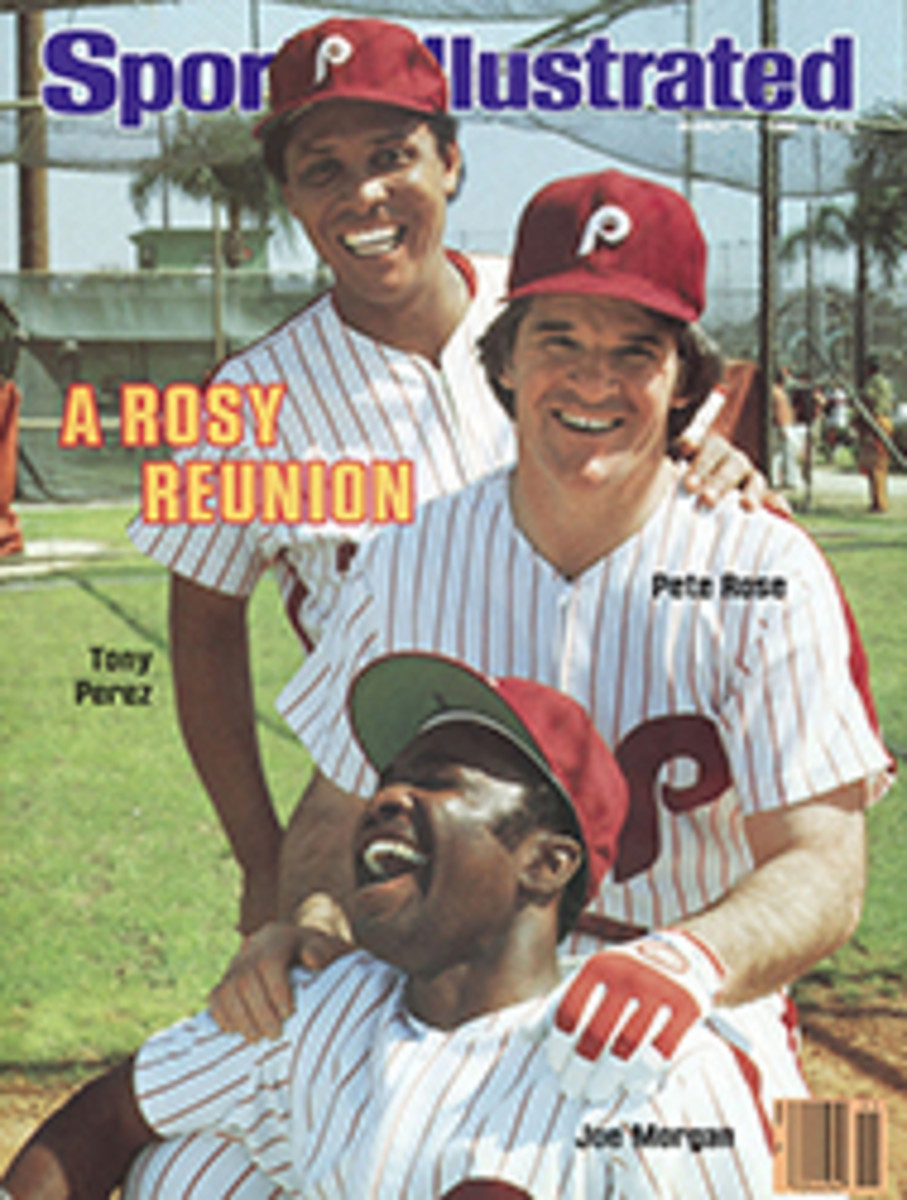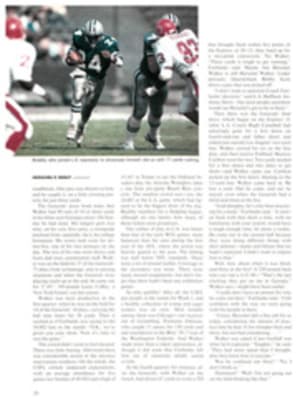
A long trip for a long shot
In January, Tommy Trotter, the racing secretary and handicapper at Florida's Gulfstream Park, added up the list of 3-year-olds nominated, at $300 per horse, to the $250,000 Florida Derby. Trotter came up with two nice round numbers: 100 horses and $30,000. Of those 100, 99 were from the North, the South and the East. Only a colt named Encourager was from the West. Encourager, unfortunately, was injured in a prep race and never made it to the Derby. But, as it turned out, that hardly meant the West went unrepresented.
One horse Trotter didn't have on his list in January was Croeso (Croy-so), a chestnut gelding whose name is Welsh for welcome, but Croeso is on everyone's list now. Last Saturday afternoon, as an 85-1 late entry from California, Croeso stunned the biggest crowd in Gulfstream's history (33,189) when he turned back three challenges by the 2-5 favorite, Copelan, to win the Florida Derby by 1¼ lengths. The winning payoff of $172 on a $2 wager nearly caused the infield tote board to short-circuit.
Long shots like Croeso are not supposed to win major events like the Florida Derby. During the race's last five runnings, favorites came through with almost boring regularity: Timely Writer in '82, Lord Avie in '81, Plugged Nickle in '80, Spectacular Bid in '79, Alydar in '78. Furthermore, the Florida Derby, the first race for classic contenders that goes as far as 1‚⅛ miles, this time was expected to give the East Coast a solid choice for the Kentucky Derby in May. That choice, it was forecast, would be the Fountain of Youth winner, Copelan.
As recently as four days before the Florida Derby, Croeso was munching oats and looking out at the rain from his stall in Arcadia, Calif. But three days before the race, he was loaded on a plane with 14 other horses from California and supplemented to the Florida Derby at a cost of $5,000, plus another $2,500 to start. It was an expensive gamble. Since 1960, only one supplemental nomination had won the Florida Derby, Ruthie's Native in 1977. Moreover, Croeso's record was hardly impressive.
Until the Florida Derby, he had started only eight times, winning twice, in a maiden voyage at the Orange County (Calif.) Fair at Los Alamitos in October and a moderate allowance race in November at Hollywood Park.
Ah, but study his form more closely and something surprising pops up. In December, Croeso ran in the $750,000 Hollywood Futurity and finished fourth behind 2-year-old champion Roving Boy, Desert Wine and Fifth Division. Croeso lost by 6¼ lengths, but beat the next horse home by 10. That fifth-place finisher: Copelan.
Croeso ended up in the Florida Derby because his co-owners, furniture man Roy Fowler and Fred Sahadi of Cardiff Stud Farm, were willing to play a long shot. Cardiff has a western division as well as one in the East; Jerry Fanning heads the California operation, while Steve DiMauro trains the eastern horses. In mid-February, Sahadi sent tapes of Croeso's races to DiMauro. DiMauro watched the films and noticed Croeso's speed. "Speed is dangerous anywhere," he says. "Always was, always is." So Croeso was shipped to Gulfstream and the Florida Derby.
Copelan broke sharply from the gate, well in front of Croeso, but by the first turn, the California horse had taken the lead. After half a mile, Croeso was 1½ lengths ahead. Copelan kept inching up to Croeso's saddle cloth only to have Croeso's jockey, Frank Olivares, let out a little on his gelding. On at least three occasions it seemed that Copelan, the winner of $500,333, would scoot past Croeso, but each time he failed. Croeso was clocked in 1:49⅘ only a second slower than Timely Writer's Florida Derby but well off Gen. Dukes' 1957 stakes record of 1:46[4/5].
The 85-1 odds on Croeso indicated that Floridians were unfamiliar not only with the West Coast horse, but also with his regular trainer, the 50-year-old Fanning. He has long been considered one of the top developers of young horses in California. Another Sahadi 3-year-old trained by Fanning is Desert Wine, a colt with a running style similar to that of stablemate Croeso: Take the lead and hang in there. The day of the Florida Derby, Fanning saddled Desert Wine to win the $110,900 San Rafael Stakes at Santa Anita by an easy 2½ lengths. That made Desert Wine the current West Coast favorite for the 3-year-old classics.
The Derby was only part of an extraordinary card at Gulfstream. Six of the 12 races were for 3-year-olds, 64 young horses in all, none of them claimers. The eighth race, for example, produced a very impressive winner in I Really Will, trained by John Veitch, the Alydar man. The ninth resulted in a smashing performance by Slewpy, the best colt in Seattle Slew's first crop of runners. Slewpy, winner of $244,140 in 1982, seemed blocked in traffic three times but somehow extricated himself to win.
The seventh race, however, was the most memorable. Making her first appearance as a 3-year-old was the undefeated filly Princess Rooney, owned by Paula Tucker of Fort Lauderdale. By the end of last season Princess Rooney was regarded by many observers as the equal of the ill-fated Landaluce. She started six times as a 2-year-old and won her races by the staggering total of 56 lengths. Her major victories came last fall, when she won the East's two top 2-year-old filly races, the Frizette at Belmont and the Gardenia at the Meadowlands, by eight and 11 lengths, respectively. Yet Princess Rooney's first start of 1983 was not against other fillies but against seven colts, five of them stakes winners.
That wasn't the way Trainer Frank Gomez had planned it. On the Monday before the Florida Derby, Princess Rooney was scheduled to run against her own sex in the $97,200 Bonnie Miss Stakes. Heavy rains early in the day, however, caused Gomez to scratch the Princess. He sat in his office that morning looking through condition books for both Gulfstream and Hialeah, trying to find a race for his filly. None was available. Then he tried to talk Trotter into putting on an exhibition race on Florida Derby Day, but with 12 events already on tap, that, Trotter said, was impossible. But he mentioned that there was a $30,000 race on Saturday for 3-year-olds that hadn't won two races worth $8,500 since Dec. 1. So Gomez entered the Princess.
Princess Rooney stumbled coming out of the gate, righted herself and took the lead while looping the field at the top of the stretch. She won by half a length over Morganmorganmorgan in a most impressive performance, covering the seven furlongs in 1:23⅘ only [1/5] slower than Slewpy ran his seven. Many experts suspected, and probably rightly so, that Princess Rooney was running at about 80% of her ability. Still, Gomez was making no predictions about entering her in the Kentucky Derby. "She's nominated to both the Kentucky Oaks and the Derby," he says. "There's a lot of time ahead." Until then, Gomez and his Princess can just sit back and watch the colts. If this is a year replete with 85-1 shots, the Princess might indeed run for the roses.
Gomez is based at Miami's Calder Racetrack, and Princess Rooney is the best horse to emerge from that track since it opened in 1971. It's always difficult to judge how good Calder horses are because the track has a synthetic surface covered with sand that makes the horses seem to bounce as they gallop. Many good Calder horses find it impossible to carry their form to other tracks. But Princess Rooney is not one of them.
After the Princess won her first four races there, she became the Queen of Calder. She ran in her first stakes race there in September, the seven-furlong Melaleuca, and won by a mere 12 lengths. John Pricci of Long Island's Newsday applied his handicapping system to Princess Rooney's Melaleuca victory and was impressed. "It was the fastest number I'd ever put on a filly," he says. "The track was slow that day, and for a filly to break 1:25 at Calder is exceptional. She ran a 1:23[4/5]. At the end of the year my figures showed that Princess Rooney was daylight ahead of Landaluce."
The two fillies, of course, never met, racing having lost a great attraction when Landaluce died in November of a bacterial infection. "It was horrible," says Gomez. "My heart went out to the Landaluce people. All they have to show for it is an Eclipse trophy and grand memories. I still have a magnificent filly to look at and race."
Princess Rooney is going to make the next two months interesting. She will take a parallel course to the colts, entering their races only when Gomez decides that the competition is so-so. Each decision will be carefully made, because, after all, her record is a spotless 7 for 7. Racing fans nowadays aren't accustomed to such success, particularly with the current crop of 3-year olds. The last major 3-year-old with such a record was Seattle Slew, who won the 1977 Triple Crown with a 9 for 9.
No matter what the colts and geldings do in the weeks leading up to the Kentucky Derby, it's Paula Tucker's Princess that people will be talking about. Will she or won't she?
PHOTO
Overlooked in Florida, Croeso and Olivares are certain to be looked over in Kentucky.
PHOTO
The gray Princess was at her royal best in her winwinwin over Morganmorganmorgan.

